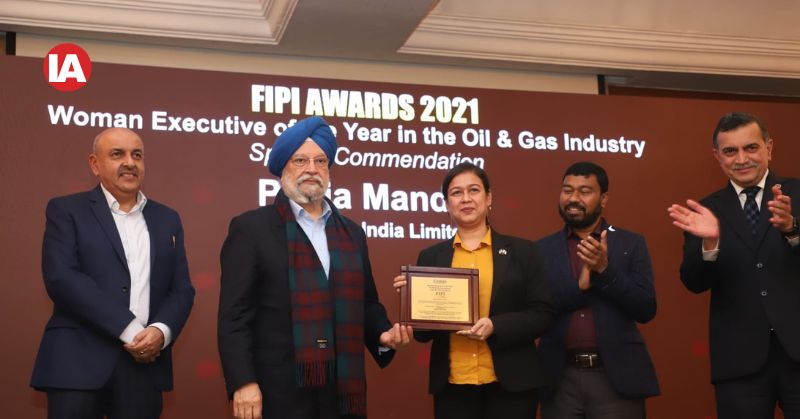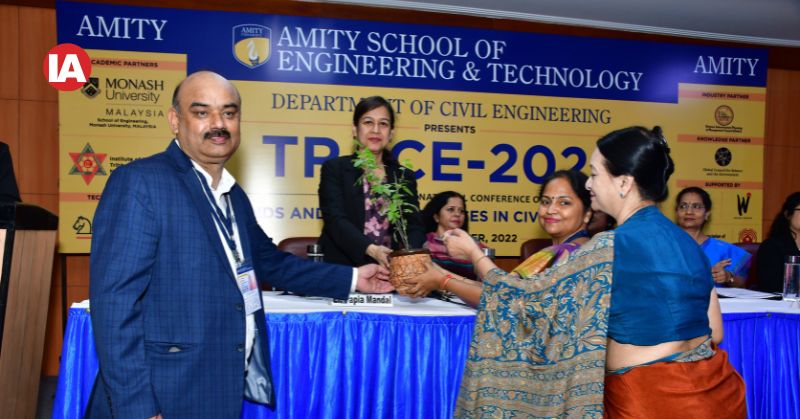Mar 08, 2025
My work is a humble contribution towards the larger mission the nation is engaged in
Ms. Papia Mandal, General Manager at Engineers India Limited, is a distinguished structural engineer with over 26 years of experience in the hydrocarbon sector. She has played a pivotal role in landmark projects, including the Dangote Refinery and BS-VI upgradation, and has been instrumental in conceptualizing engineering standards for extreme climatic conditions. A recipient of prestigious awards such as the IStructE National Award and the FIPI Woman Executive of the Year (Special Commendation), she continues to drive innovation, sustainability, and knowledge-sharing in the industry.
![[object Object]](https://admin.industrialautomationindia.in/storage/womensdayspecial/womensdayspecial-MNeRJUIha1IEouxRY71zCWX5nUSRPDHbXDW6PY3B.jpg)
Papia Mandal, General Manager, Engineers India Limited.
With 26 years of experience in structural engineering and contributions to landmark projects like the Dangote Refinery and the BS-VI upgradation project, what inspired you to specialise in civil-structural engineering for the energy and oil & gas sectors?
Being in this sector for a relatively long period is extremely fulfilling and exciting. Am truly indebted to my company for providing me not only guidance, but also opportunities to engage in landmark projects in continuity. Contributing to one of the world’s largest refinery and petrochemical complexes like Dangote Petroleum Refinery is one of its own kind of experiences. The I structures of the complex are of mammoth size and extremely complex in nature, and perhaps a challenging dream for any civil-structural engineer. The memories and the experience gained during the association of this project remains a lifetime pleasure and treasure. On the other hand, the Supreme Court-driven BS-VI upgradation projects presented a unique challenge, as they were of significant national importance and had to be executed within the strict timeline set by the Hon’ble court. The thrill associated with the challenge was of monumental significance!
Civil-Structural engineering is analogous to the backbone of the energy and oil & gas sector projects. It not only translates the design and core concepts on paper, but also provocatively invokes the physical behavior of structures under various kinds of static and dynamic forces acting over its lifespan. Witnessing the structures serving the National endeavors decades and sometimes over centuries is extremely inspiring and motivating.
As the General Manager of EIL, how do you approach balancing technical leadership with mentoring and inspiring the next generation of engineers?
While evolving over the decades, I feel fortunate enough to get actively associated with extremely bright and sharp acumen led engineers. They are certainly the best amongst the lot. Guiding them towards the path of greater and higher success in life and career remains my passion. Intellectual exchanges, sharp discourses and generation of a plethora of ideas towards problem resolution in relation to various technical and managerial issues is perhaps, one of the most rewarding experiences for me.
It would not be out of place to mention that the prevailing culture in my Company, viz., Engineers India Limited, is very much instrumental in this growth journey. The company is unique in promoting free flow of knowledge vertically and horizontally with very positive vibes and amidst a creative ambience is just a reflection and a core modern version of traditional gurukuls. With longevity of time spent the process of gaining and imparting knowledge remains work in continuity and enables inculcation of the spirit to guide and inspire the next generation almost naturally and with volition.
You played a significant role in conceptualising engineering standards for the Mongol Refinery project under extreme climatic conditions. What challenges did you encounter, and how did you navigate them?
Mongolian climate conditions are extremely harsh. Winter is prolonged and lasts for about eight months in a year, wherein temperatures drop up to around -35 degree Celsius. The refinery structures were of structural steel and their foundations were in concrete. Concrete construction was to be performed in an ambient temperature for which a very short period was available, only during the summer. In addition to that, there was ice in the subsoil, which needed special protection measures for the design of foundations. Besides that, structural steel normally used for refinery projects was not suitable for the Mongolian harsh weather conditions. Elaborative specification backed up with detailed study, for the material, its construction and fabrication were evolved and elaborated for implementation. Designs were made to ensure that site work was reduced to the extent possible.
Your technical papers and presentations cover diverse topics, from seismic retrofitting to sustainable precast practices. Which research or publication do you consider the most impactful, and why?
All the technical papers and presentation contents are like my offspring, selecting one over the other is a difficult task. However, if I have to select one out of the many I would say, ‘Transfer of Lateral Load to Stiffer Frames in Industrial Structures’. Various structures of the energy sectors have complex technical design requirements and at the same time stringent operation requirements also. Tradeoff between these two requirements and maintaining a balance, so that structural stability and integrity is maintained while facilitating smooth operation of the equipment, housed over the structure is a state-of-the-art design technique. This study addressed one such challenge for structural engineers. Moreover, this work was dedicated to our Ex Head of the Department, as a tribute to the enormous knowledge he had imparted during his prolonged technical discourses and interactions with us. The emotive aspect associated with this paper therefore too draws it extremely close to my heart.

to each other’ – Papia Mandal.
As the recipient of prestigious awards like the IStructE National Award and the Woman Executive of the Year (Special Commendation), what do these recognitions mean to you personally and professionally?
The IStructE National Award provided me with a platform to demonstrate the work carried out hitherto,and opened it to a galaxy of experts, whose guidance and direction served in providing the avenues to achieve perfection by exploring newer and niche areas to serve the higher cause of the industry.
The prestigious FIPI award provided me an opportunity to launch myself in the league of excellence for achieving greater heights and exhibiting more constructive and meaningful work in subsequent times.
Your efforts to integrate sustainability in the hydrocarbon sector are commendable. Could you elaborate on how your work aligns with India’s energy goals?
Under the visionary leadership of our Honorable Prime Minister, the nation is excelling at a breakneck pace. My own work on various issues like ‘Enhancing Energy Self-sufficiency’, ‘Strengthening India's Energy Security with Green H2 Integration’, ‘Hydrogen Economy’, ‘Strategic Shift to Petrochemicals’, and ‘Building on India’s Growth Story with Energy and Renewables at core’, are catered to establish a balance between the Energy-Economy-Emission trilemma. My work is a humble contribution towards the larger mission that the Nation is engaged in!
As someone who has pursued continuous learning through programs at IIT Delhi, IIM Calcutta, and currently at IIM Kozhikode, how do you view the role of ongoing education in career advancement?
I believe Higher Management and Leadership Role oriented knowledge with a strategic perspective and visionary orientation is extremely important. Pursuing Leadership from IIM Calcutta and Strategic Management from IIT DMS have added hugely to my credentials for excelling in the arena of corporate visioning and professional skilling.
Further, pursuing MBA from the numero-uno institute like IIM Kozhikode, one of the top three NIRF ranked IIMs of the nation, has profoundly added to my skill in the crucial areas like Finance, Operations and Project Management. Am certain that the learning of the past few years has enabled a transformative change in my approach towards organisational management and strategic thinking; besides, ensuring my horizontal growth for rendering more efficient and strategic services in my profession.
Having mentored young engineers in India and abroad, what do you think is the most critical skill for aspiring professionals in engineering today?
While mentoring young engineers through various interactions as well as some structured training, I felt the critical skills for aspiring professionals are a simplistic approach and flexibility towards problem solving. Industry and academia are complementary to each other. Proper amalgamation between the two for finding a timely and effective solution is the need of the hour.
What is your opinion on the role of Industrial Automation magazine in showcasing industry trends and empowering women in technology and automation?
The Industrial Automation magazine is a great motivator not only for women professionals, but also the entire industrial fraternity, as it opens up the avenues and portals of carrying out recognisable work, which anyway, is a humble contribution towards the sustained building of our Nation.
This is bound to have a telling impact on the morale of the upcoming leaders in raising their standards to even higher levels of performance and contribution for the larger benefits of the nation in general and the organisation in particular.
What are the three words that best describe how it feels to be a finalist in the Women in Tech 2025 competition?
Several thoughts rush through the mind but the three words which readily come to mind are:
Persistence, Perseverance. Profoundness.
This runs through both in my personal endeavours as well as my professional outlook!
(The views expressed in this interview are personal, not necessarily of the organisation represented)

Ms Papia Mandal, M-tech from IIT-Delhi, is General Manager, Engineers India Limited – one of the leading PSUs and knowledge hub. While being associated with the Hydrocarbon Industry for more than 26 years, she has acquired vast experience in Refineries, Petrochemicals, Pipelines, Gas Processing Stations of various Domestic and Overseas projects. Recently handled one of the biggest refineries of the World, Dangote Refinery, Nigeria along with Supreme court driven BS-VI Upgradation Projects of some of the refineries. Was also instrumental in Conceptualising engineering standards and guidelines for a project supported through Line of Credit by GoI in the coldest climatic conditions of the world, for the Mongol Refinery, Mongolia.
She is the recipient of Woman Executive of the Year 2021 (Special Commendation) in Oil and Gas Industry Issued by Federation of Indian Petroleum Industries (FIPI) and awarded by Hon'ble Minister of Petroleum for all-round achievements and traversing a successful career path with professionalism in the Oil and Gas sector.
She has also bagged the IAStructE National Award – “Outstanding Woman Structural Engineer of the Year” Issued by Indian Association of Structural Engineers in July 2022 Awarded in recognition of her outstanding contribution to Structural Engineering.
In the quest of knowledge, she has pursued a Management and Leadership program from IIM Calcutta, and Strategic Management from the Department of Management Studies, IIT Delhi. Presently she is pursuing MBA from IIM Kozhikode.
She has published many technical articles in various journals including Journal of Centre for High Technology by Ministry of Petroleum and Natural Gas, Govt. of India and the Journal of Federation of Indian Petroleum Industry. She has also presented numerous technical papers in national and international conferences.